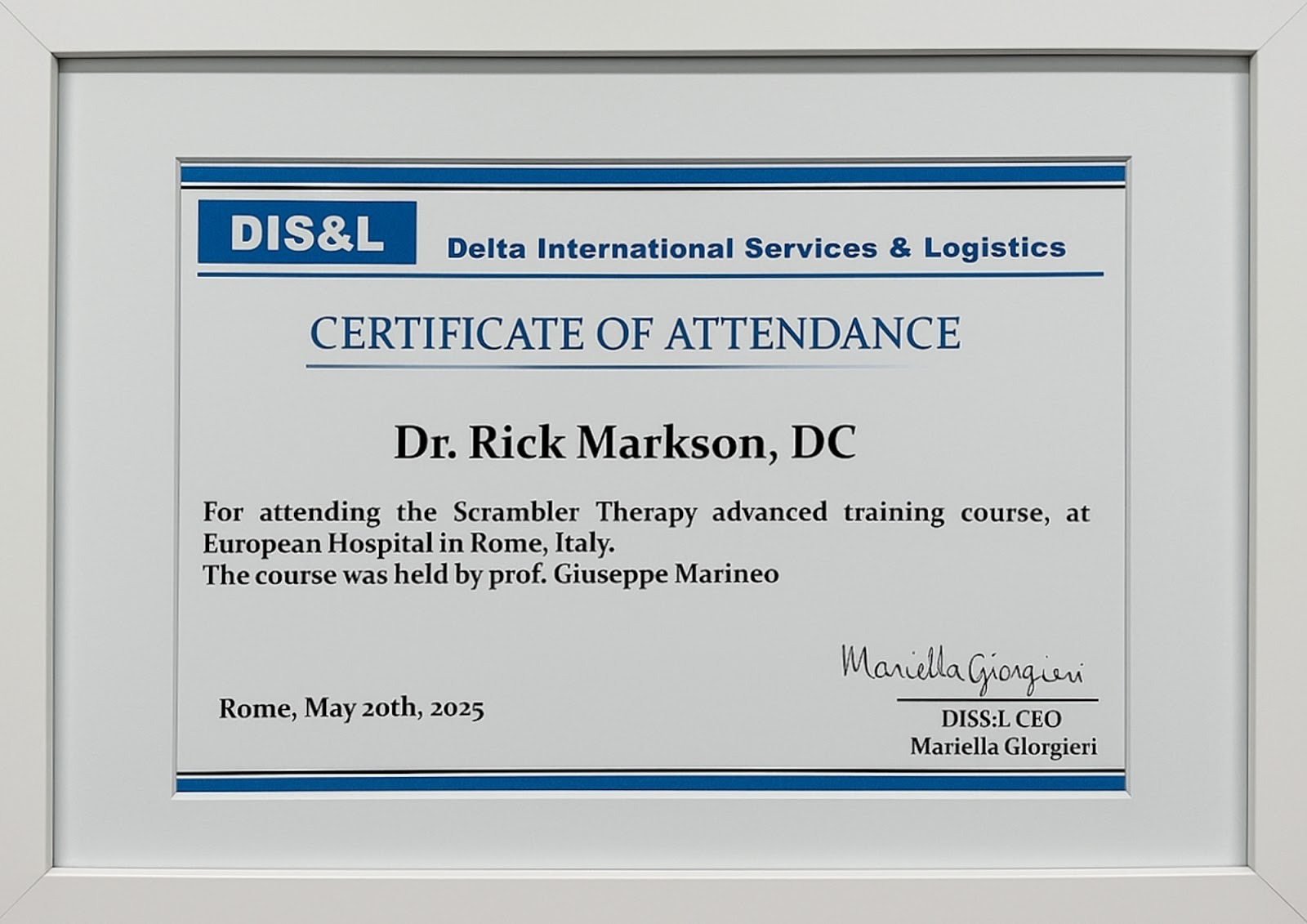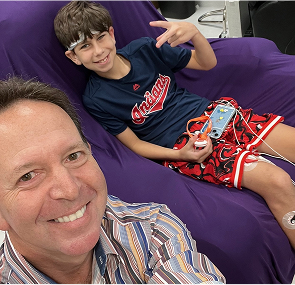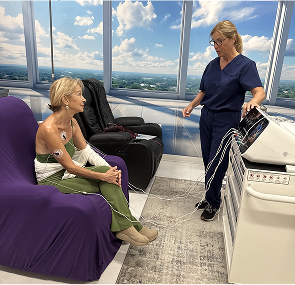Scrambler Therapy vs. Surgery: Why Non-Invasive Wins
.jpg)
Scrambler therapy is a non-invasive pain treatment that retrains how the brain interprets nerve signals. It uses the Calmare device, which sends electrical impulses through electrodes placed on the skin. These impulses mimic healthy nerve signals, disrupting chronic pain messages.
The therapy relies on neuroplasticity—the brain’s ability to rewire itself. By stimulating affected dermatomes, scrambler therapy replaces false pain messages with normal sensations like light touch or warmth. This process is called sensory reprogramming.
Conditions treated include:
- Neuropathic pain (from diabetes or chemotherapy)
- Sciatica and nerve compression syndromes
- Failed back surgery pain
- Complex Regional Pain Syndrome (CRPS)
- Post-herpetic neuralgia (shingles pain)
Scrambler therapy offers an alternative to surgery by modulating pain without tissue damage, anesthesia, or long recovery.
Understanding Surgical Interventions for Chronic Pain
Surgical approaches to pain management include spinal fusion, nerve ablation, disc replacement, and spinal cord stimulators. These aim to physically alter pain pathways or stabilize damaged structures.
Risks of pain surgeries include:
- General anesthesia complications
- Tissue damage and inflammation
- Post-surgical infections
- Long hospital stays and rehab needs
- Uncertain outcomes, including persistent pain
While surgery can be lifesaving in certain cases, invasive pain relief often comes with high risks, longer recovery, and greater costs. Many patients look for surgery alternatives when pain is the only indication.
Scrambler Therapy vs. Surgery – A Side-by-Side Comparison
Patients comparing therapy vs. surgery for nerve pain often find that scrambler therapy offers faster relief, fewer complications, and lower financial burden.
Who Should Consider Scrambler Therapy Over Surgery?
Scrambler therapy is ideal for patients with chronic neuropathic pain who want a non-invasive pain option. It suits those who are:
- Elderly patients at higher surgical risk
- Individuals with co-morbidities (e.g., heart disease, diabetes)
- Patients wanting to reduce or avoid opioid use
- People with a history of failed back surgery
- Candidates with pain diagnoses not requiring structural repair
Patients should avoid surgery for pain alone when scrambler therapy offers effective, low-risk relief.
Real-World Results: Scrambler Therapy vs. Surgery Outcomes
Clinical studies show scrambler therapy reduces pain scores by up to 70% on standard scales. Many patients report long-term remission lasting months or years.
Examples:
- Cancer patients with chemotherapy-induced neuropathy experienced significant pain reduction without additional medication.
- CRPS patients reported functional improvement and reduced flare-ups.
- Elderly patients avoided surgery and regained mobility after 10–12 sessions.
By contrast, surgical recovery stories often include setbacks, complications, or persistent pain. Studies reveal that 30–40% of spinal surgeries fail to eliminate pain completely.
Costs of Scrambler Therapy vs. Surgery
Scrambler therapy cost varies by clinic but usually involves 10–12 treatment sessions, with modest out-of-pocket fees. Some insurance providers cover part of the cost under non-surgical pain management.
In contrast, surgery expenses for pain include:
- Surgeon’s fees
- Anesthesia costs
- Hospital bills
- Post-surgical rehab and medications
- Potential repeat procedures
Cost comparison: Scrambler therapy often proves more cost-efficient long term, especially when factoring in quicker recovery and fewer complications.
FAQs – Scrambler Therapy vs. Surgery
Is scrambler therapy safe?
Yes. It is FDA-cleared, non-invasive, and has a strong safety record.
Can scrambler therapy replace surgery?
In many cases, yes. It is an effective alternative for nerve-related pain but may not replace surgery for structural damage.
Is surgery more effective for chronic pain?
Not always. Surgery carries higher risks and uncertain long-term outcomes, while scrambler therapy shows consistent efficacy in neuropathic pain.
How long does scrambler therapy last?
Relief may last months to years, with booster sessions available if pain returns.
The Science Behind Pain Signaling and Disruption
Pain originates from nociceptors in tissues, which send signals through C-fibers and nerve pathways to the spinal cord and brain. Chronic pain often results from a faulty brain feedback loop, where the body perceives pain even without tissue damage.
Scrambler therapy interrupts this loop by sending synthetic “no pain” signals to the sensory cortex. This pain signal interruption reprograms the nervous system, restoring normal communication and reducing false alarms.
Unlike TENS devices, scrambler therapy does not block signals temporarily—it retrains the nervous system for lasting results.
Future Trends – Scrambler Therapy in Modern Medicine
Scrambler therapy is gaining global recognition as a next-gen pain treatment. Research continues into new indications, including fibromyalgia, phantom limb pain, and migraine management.
Future directions include:
- Broader FDA clearance for expanded conditions
- Integration into standard oncology care for chemotherapy pain
- Improved device innovation with AI-driven electrode mapping
- Clinical pipeline studies proving long-term efficacy
The future of scrambler therapy points toward wider adoption in hospitals, pain clinics, and integrative care models.
The Psychological Impact of Choosing Surgery vs. Scrambler Therapy
Surgery often brings decision anxiety, fear of complications, and post-treatment depression if outcomes disappoint. Patients face mental stress from hospital stays and prolonged recovery.
Scrambler therapy, in contrast, offers recovery optimism. Non-invasive treatment reduces anxiety, gives patients a sense of control, and supports a more positive patient mindset.
The psychological burden of surgery should not be underestimated, especially when non-invasive alternatives exist.
Post-Treatment Expectations – Scrambler Therapy vs. Surgery
After scrambler therapy:
- Patients resume normal activities immediately.
- Some experience lasting relief after the first few sessions.
- Periodic maintenance sessions may be needed.
After surgery:
- Patients face weeks of rehab and physical therapy.
- Pain flare-ups are common during recovery.
- Long-term outcomes may involve recurrence or additional procedures.
When comparing healing timeframes, scrambler therapy provides faster return to function and better quality of life.
Ethics of Recommending Surgery When Non-Invasive Options Exist
Medical ethics require doctors to recommend treatments that balance patient rights, safety, and informed consent. Recommending surgery when non-invasive options like scrambler therapy exist raises ethical concerns about overuse and financial incentives.
Ethical practice encourages:
- Second opinions before surgical decisions
- Transparency about risks and alternatives
- Prioritizing patient-centered care
Overprescription of surgery can undermine trust, while recommending scrambler therapy first aligns with ethical guidelines for responsible pain management.
Experiencing Chronic Pain in South Florida?

Discover South Florida Scrambler Therapy is one of the nation’s leading clinics for noninvasive chronic pain relief, offering FDA-cleared Scrambler Therapy® for adults and children. Co-founded by Dr. Rick Markson, one of the few practitioners worldwide to receive advanced certification directly from the therapy’s inventor in Rome, our clinic delivers globally recognized expertise with compassionate, personalized care. If you or a loved one is living with treatment-resistant nerve pain, we invite you to schedule a consultation and explore a life beyond pain.
Recommended Reads:
📘 What is scrambler therapy?
📘 What to Expect During a Scrambler Session
📘 CRPS Pain Relief Without Drugs—Real Patient Stories
📘 Conditions that scrambler therapy can treat
Take the Next Step: Free Consultation at South Florida Scrambler

Every day counts when we suffer from chronic pain. South Florida Scrambler Therapy offers a free initial consultation to determine if Scrambler is right for you. Schedule Today:
- Speak directly with Dr. Rick Markson’s team
- Learn about treatment protocols and insurance
- Complete a customized treatment plan
- Start seeing results within days, not months
📞 Call Now or Visit website: www.southfloridascramblertherapy.com
📍 We serve Palm Beach, Fort Lauderdale, and Miami from our location at 100 NW 100th Ave, Plantation
You Can Follow Us through Our Social Media:
📸Instagram—Day-in-the-life stories from our patients
👍Facebook—Success journeys and community support
You deserve to laugh, and enjoy life without pain. The journey starts here.
Start Your Pain-Free Journey Today





.jpg)